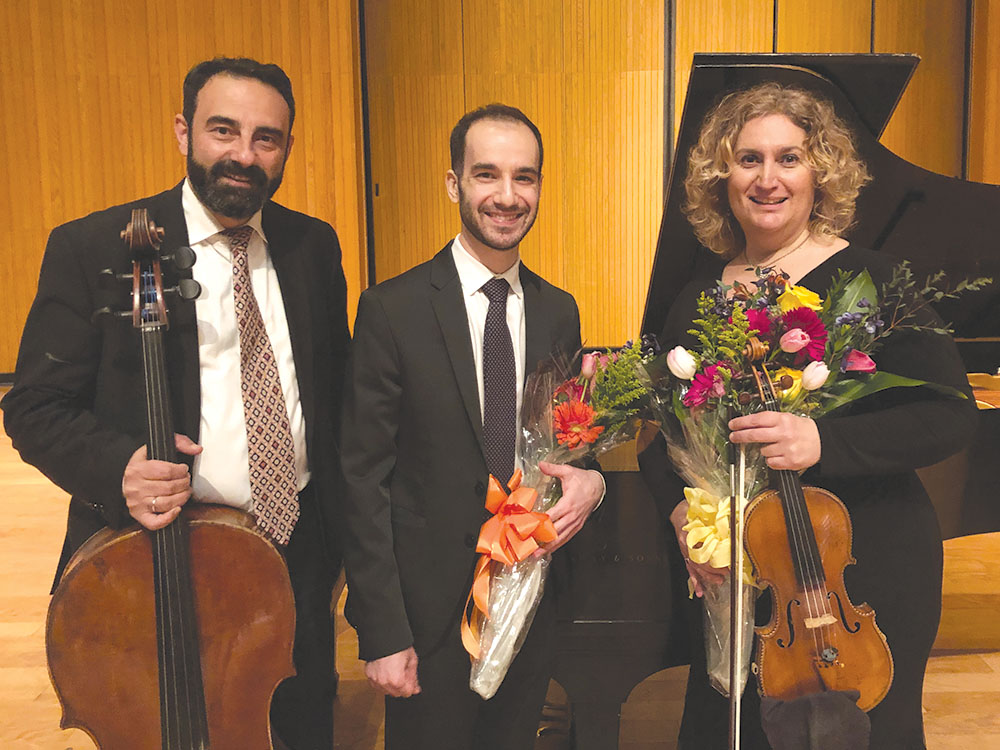
Photo: Barlow Der Mugrdechian
Christine Pambukyan
Staff Writer
“Komitas, a survivor of the Genocide and a symbol of the Armenian people, used the power of music to assert life,” proclaimed pianist Dr. Michael Krikorian, as he explained the meaning behind the name of his ensemble, the “Komitas Trio.”
On Friday, March 4, 2022, the Philip Lorenz International Keyboard Concert Series, the Fresno State Armenian Studies Program, the Thomas A. Kooyumjian Family Foundation, and the Greater Fresno Chapter of the Armenian General Benevolent Union presented the “Komitas Trio,” as part of the 50th Anniversary Season of the Keyboard Concert Series. The “Komitas Trio” includes Michael Krikorian on piano, Aroussiak Baltaian on violin, and Garik Terzian on cello.
Krikorian, a pianist, composer, and educator, has won many top prizes around the world. He has performed and competed across the United States, Italy, France, China, and South Korea. A private piano teacher and an adjunct professor of music at Los Angeles Pierce College, Krikorian also composes music for concerts on stage and visual media.
Baltaian, a member of the Pasadena Symphony Orchestra, often spends her time performing with the Los Angeles Philharmonic Orchestra. She has performed as a soloist and recitalist in the United States and Europe. Baltaian has received many top prizes as a well-renowned soloist, chamber musician, and recording artist.
Terzian, a soloist and chamber musician, has performed throughout the former Soviet Union, the United States, Mexico, Spain, Ireland, and the Czech Republic. Beginning his career as a cellist at the age of six though the guidance of his father in then Czechoslovakia, he has since performed with the Armenian State Philharmonic Orchestra and the Armenian State Chamber Orchestra.
Michael Krikorian began the concert with a thank you to the sponsors, audience, and university. He then, in a manner similar to that of a master class, introduced each composer to the audience to give more context to each piece.
 First on the program was Clara Schumann, a nineteenth-century composer, who was dealing with the illness of her husband and a miscarriage, as she created her “Trio in G minor” in 1845-46. Next, Dmitri Shostakovich dedicated “Trio in E Minor, Op. 67” to a friend who passed away during World War II. Finally, Arno Babadjanian, who after returning to Armenia from studying with Vissarion Shebalin in Moscow in 1950, composed “Trio in F-sharp Minor” as he taught at the conservatory in Yerevan. Overall, the context in which each composition was written made for a melancholy repertoire. This matched what is currently happening in the world: a war in Ukraine, Armenia attempting to recover from a war in Artsakh, and a global pandemic.
First on the program was Clara Schumann, a nineteenth-century composer, who was dealing with the illness of her husband and a miscarriage, as she created her “Trio in G minor” in 1845-46. Next, Dmitri Shostakovich dedicated “Trio in E Minor, Op. 67” to a friend who passed away during World War II. Finally, Arno Babadjanian, who after returning to Armenia from studying with Vissarion Shebalin in Moscow in 1950, composed “Trio in F-sharp Minor” as he taught at the conservatory in Yerevan. Overall, the context in which each composition was written made for a melancholy repertoire. This matched what is currently happening in the world: a war in Ukraine, Armenia attempting to recover from a war in Artsakh, and a global pandemic.
After an informative introduction, the trio began their concert with Schumann’s “Trio in G minor, Op. 17.” The piece includes “Allegro Moderato,” “Scherzo – Trio,” “Andante,” and “Allegretto.” The first of two melancholy compositions began with a serious movement, followed by a happy and sweet melody, then a passionate tune, and completed with a quick, worried, angry, and passionately distressed movement.
The “Komitas Trio” then performed Dimitri Shostakovich’s “Trio in E Minor, Op 67,” composed in 1944. The piece includes “Andante–Moderato,” “Allegro Con Brio,” “Largo,” and “Allegretto – Adagio.” This composition began with a beautiful cello solo that evolved into a serious trio piece. The next two movements were passionate and dramatic, using harmonics in a breathtaking fashion. The final piece of the composition began with a quiet pizzicato duet from the violinist and cellist. The piece then grew into a big, loud, and passionately tense movement that allowed the audience to feel the pain of the loss of a beloved friend.
After a brief intermission, the trio performed Arno Babadjanian’s “Trio in F-sharp Minor,” composed in 1952. The piece includes “Largo –Allegro Espressivo,” “Andante,” and “Allegro Vivace.” This composition gave the audience a break from the sorrow-filled emotions of the previous two compositions and replaced those emotions with nostalgia and a love for one’s motherland.
Throughout the concert Krikorian moved closer to his keys when the music called for pianissimo, as if he was tiptoeing though the quiet notes. With each fortissimo, Krikorian would jump in his seat with passion. Baltaian and Terzian seemed to enjoy the music along with the audience, each moving along with the music in their own way with facial expressions that matched the tone of each song. Each member of the Trio fit in like a puzzle, with no clashing of sound and no fighting for dominance of the piece. Every nod at the start of each piece made for smooth transitions between solos and a synchronized group, creating a pleasant and enjoyable concert.
Once the last note of Babadjanian’s “Allegro Vivace” rang throughout the Concert Hall, the audience stood and cheered. One of the music students presented the Trio with a bouquet in appreciation of their talent. The audience continued to cheer until the musicians returned for an encore performance of Arno Babadjanian’s “Anurjner” (Dreams). After another standing ovation, the audience had the opportunity to meet and get to know the talented musicians in the lobby
 Hye Sharzhoom Armenian Action
Hye Sharzhoom Armenian Action